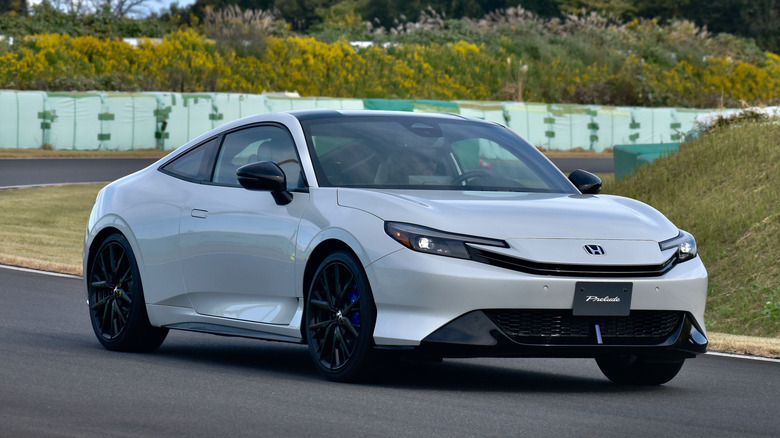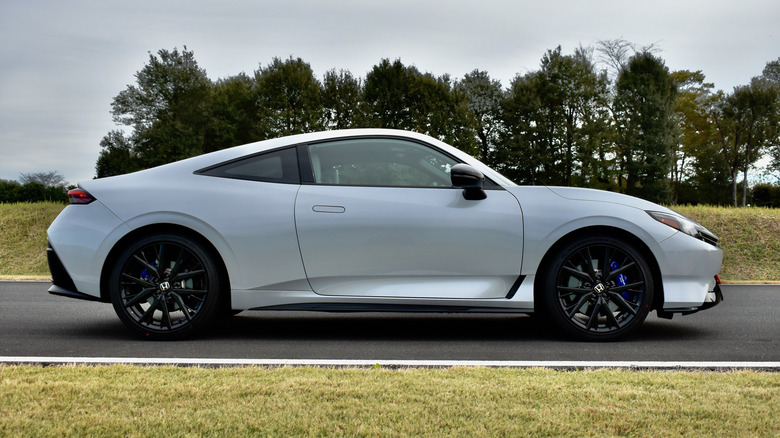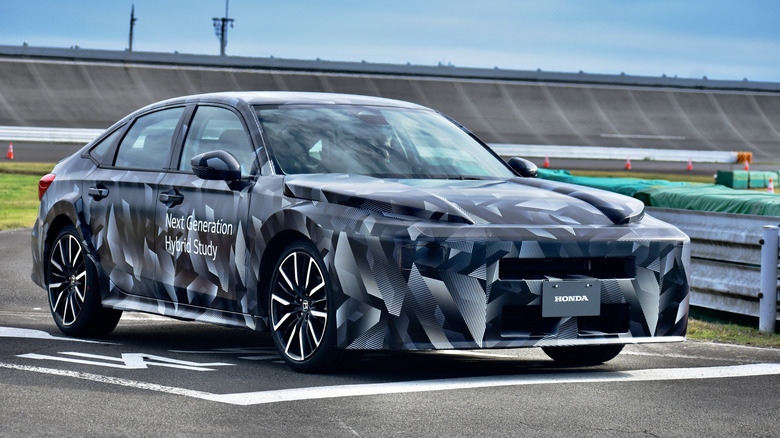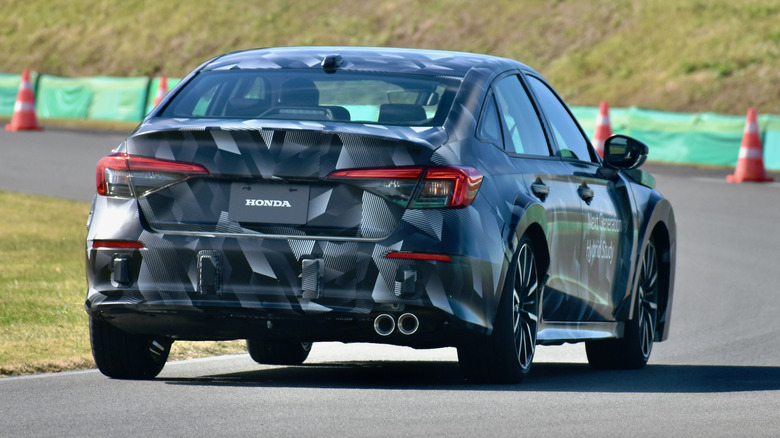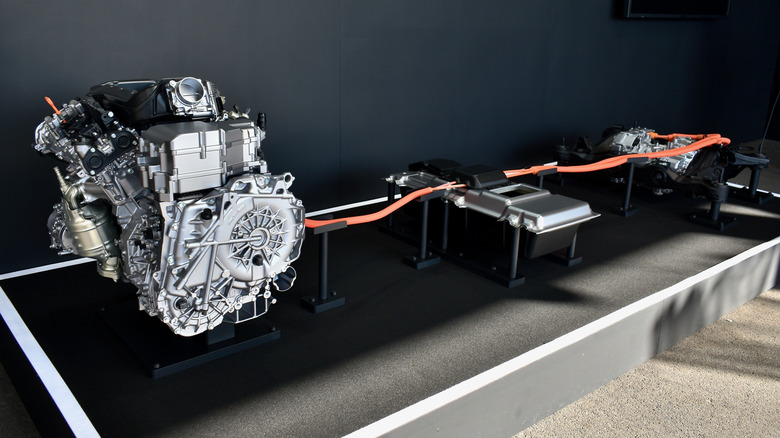After Driving The New Honda Prelude, I Think Toyota Finally Has A Reason To Worry
It may not be synonymous with hybrid powertrains like fellow Japanese automaker Toyota (even if the Insight beat the Prius to production), but Honda is just as committed to them. Hybrids now represent the majority of sales for the popular Accord sedan and CR-V crossover, and Honda wants that to become the norm for all of its models, with a goal of 60% global hybrid sales in the near future. It starts with the reborn 2026 Honda Prelude that reaches dealerships later this year, and continues with 13 new hybrid models launching over a four-year span starting in 2027.
To reach that goal, Honda will launch a greater variety of hybrid models than ever before, with new powertrains that further improve fuel economy while also catering to a greater variety of market segments from sporty coupes to large SUVs, and new vehicle architectures that share DNA with the automaker's upcoming 0 Series electric vehicles. During a recent visit to Honda's proving grounds in Tochigi, Japan, we got a preview of what that hybrid future will look like.
Prelude to greatness?
For 23 years, the Honda Prelude was a sporty coupe that showcased new technology like four-wheel steering and torque vectoring, and that will once again be the case when the Prelude returns to Honda showrooms for the first time since 2001. This time, the focus is on a new flavor of Honda's two-motor hybrid system that provides a sportier driving experience.
The new Prelude borrows its 2.0-liter Atkinson-cycle four-cylinder gasoline engine from the Civic Hybrid, and as in all current Honda hybrids, a pair of motors replace a conventional transmission, with the inline-four able to drive the front wheels directly via a clutch in certain situations. The total system output of 200 horsepower also matches the Civic Hybrid.
What's different here is a new feature called S+ Shift that makes the hybrid system respond like it's got a conventional multi-speed transmission. While the Linear Shift Control system in the Civic Hybrid does this to some extent, simulating shift points and syncing rpm up with vehicle speed more than other Honda hybrids, S+ Shift takes things further by holding the fake "gears" and simulating rev-matched downshifts for an even sportier feel.
Even after just three laps of a test track at the Honda proving grounds, these changes made a big impression. The hybrid system's response was quite different from that of the Civic, and a sea change from the Accord and CR-V, where the combustion engine is treated more as a generator.
A very different hybrid driving experience
Aside from a subtle added shove of electric-motor torque, the Prelude does an excellent impression of a non-hybrid car with a geared automatic transmission. Accelerating down the straightaway, it snapped through clean, precise shifts. When it was time to brake for a corner, pressure on the pedal triggered downshifts to keep the revs up—just as in many performance cars with conventional transmissions. A pleasant side effect is a crisp exhaust note in place of the industrial droning of most Honda hybrids.
While there were no physical gears to speak of, all of this was done well enough that the artificial shifts didn't feel obviously fake. This type of response will also be more familiar to drivers coming from other cars, although it's unclear what impact it will have on fuel economy (Honda hadn't published EPA ratings for the Prelude at press time). Where most Honda hybrids encourage you to drive efficiently, this one encourages you to drive exuberantly.
As for the rest of the car, first impressions are mostly encouraging. Turn-in was quick and decisive, although that shouldn't be surprising considering that the Prelude has Civic Type R-based front suspension. That was counterbalanced by an utter lack of steering feel, although the helm was at least taut and precise. More power would also be nice to help further differentiate the Prelude from the Civic Hybrid.
A big flex
The Prelude is the sportiest model in Honda's current hybrid lineup but, appropriately for a car with that name, it's also likely to set the stage for future hybrid models. At least, that's the impression we got after a handful of laps in a prototype for Honda's next-generation hybrid system and vehicle architecture. Honda calls it a "midsize" architecture, but it will also be used for what are considered compact models in the U.S., such as the CR-V and Civic.
With this architecture, as well as the one for the all-electric 0 Series models, Honda is ignoring conventional wisdom. Instead of making the structure as rigid as possible and trying to tune for ride and handling purely with the suspension, Honda is introducing a bit of what engineers call "suppleness" into the front end. By removing some structure, the chassis can flex a bit and help shift weight to the outside tires when cornering, giving them more grip and thus improving overall handling, according to the engineers.
For internal-combustion vehicles, the main difference in rigidity is in the area underneath the area and behind the shock towers. To compensate for this, Honda claims to have engineered a different crash-load path that relies less on the underfloor area to direct crash forces away from occupants. That leaves a simpler structure that, in addition to its claimed handling benefits, is lighter and likely easier to manufacture—helping to keep costs down.
Same power, better response
The new hybrid system paired with this platform won't be as radical of a rethink, but fuel economy will improve by up to 10% compared to current Honda hybrid models, and the automaker is aiming for cost reductions as well. It will be based around a 2.0-liter four-cylinder engine as in the current Civic Hybrid, CR-V Hybrid, and Prelude, but SUVs will have a second, lower direct-drive option. Sedans and hatchbacks will still use their gasoline engines to drive the wheels directly only at certain highway speeds.
Power output hasn't been finalized, but engineers said it will likely be close to that of the current Civic and CR-V Hybrids with improved response to make them feel more engaging. All future hybrid models based on this platform will also get the Prelude's S+ Shift system which, based on a few laps in the prototype, at least, should make them fun to drive as well.
Prelude won't be an outlier
The prototype had the next-generation platform and hybrid system, crammed into a current-generation Civic body shell. Honda engineers said it was mechanically representative of what will go into production starting in 2027, but that tuning hadn't been finalized. The engine sound and throttle response in particular were dialed up, giving the prototype a surprisingly sporty character that engineers hope to preserve in future production models, but that could be pulled back a bit.
Ignoring the camouflaged bodywork and interior, as well as the extra set of doors, the prototype felt very similar to the Prelude. Its engine also chattered happily as we accelerated down straightaways, and its hybrid system simulated snappy downshifts and blipped the throttle when braking for corners. The current Civic Hybrid is a pleasant car to drive, but this felt like a big step up.
A handful of laps in each car wasn't enough to definitively parse handling differences, but the hybrid prototype also felt about as eager and confident in the corners as the Prelude—they're just arriving at that point from two different directions. The Prelude is doing it with suspension that emphasizes mechanical grip and body control, while the prototype is using its chassis "suppleness" in a way that could allow for increased bandwidth for comfort on surfaces less perfect than the pristine test tracks where we sampled these cars.
Bigger hybrid SUVs too
Small cars are a better starting point for maximizing fuel efficiency, but Honda knows that the U.S. market also demands bigger SUVs. In 2027, it will launch another new hybrid system for models like the Pilot and Passport. What Honda calls its "large-size hybrid system" will keep the two-motor drive philosophy from previous models, but incorporating a V6 engine for the first time. This will be a newly-developed engine with efficiency improvements over the current 3.5-liter V6, while making more power, according to Honda. The automaker expects a 10% improvement in fuel economy over similar-sized non-hybrid SUVs, with a 30% improvement in response at wide-open throttle. This will also be the first Honda hybrid system designed specifically with towing in mind.
This new system will also be the first from Honda with a dedicated rear electric motor since the Acura RLX Sport Hybrid sedan. Current all-wheel drive Honda hybrids use a mechanical driveshaft and rear differential to transfer power to the rear wheels, but here the rear-mounted motor does that without any mechanical connection to the engine. Known as a "through the road" all-wheel drive system, this setup is used in most all-wheel drive Toyota hybrids.
Honda engineers said this provides greater total system output and efficiency than a mechanical all-wheel drive system. That such hybrids will coexist with the sporty Prelude coupe shows an impressive commitment to the technology—and the variety that makes cars so interesting in the first place.
